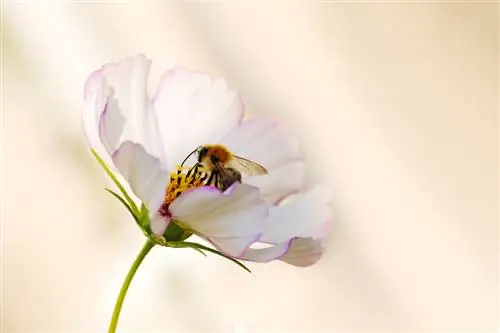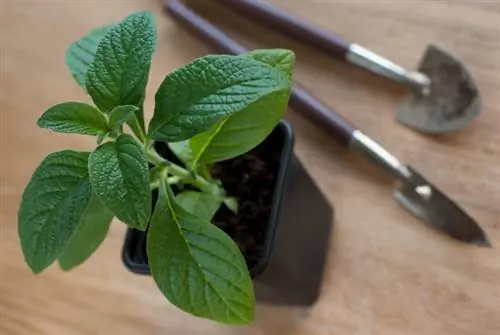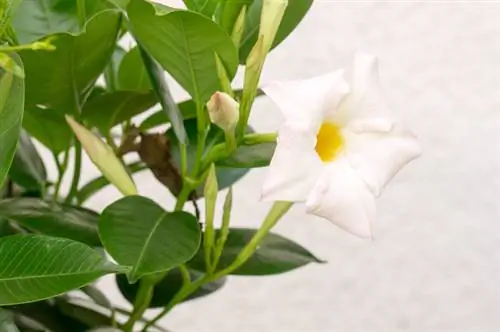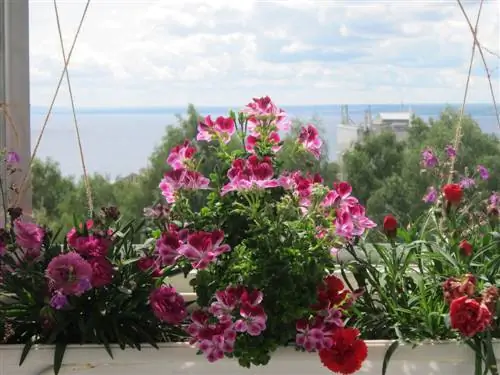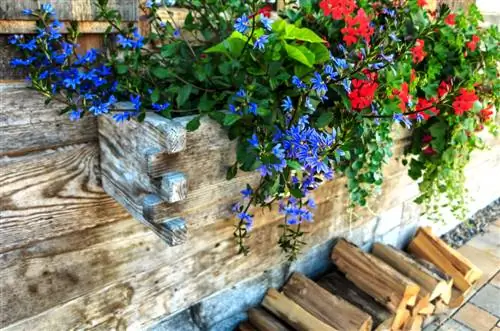- Author admin [email protected].
- Public 2023-12-25 17:45.
- Last modified 2025-01-23 11:20.
With their lavish flowers, annual Cosmea bipinnata steal the show from perennials. From May until the first frost, decorative baskets appear in the flower bed, swarmed by bees, bumblebees and butterflies. The following answers to frequently asked questions explain in detail how you can realize this feudal summer dream in your garden.
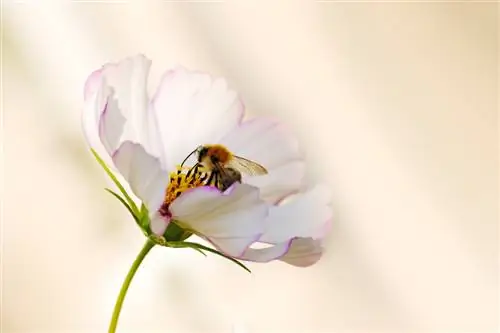
How to care for cosmea in the garden?
To optimally care for Cosmea in the garden, they should be planted in a sunny, warm location. Water regularly, fertilize sparingly and cut off withered flowers to encourage the plant to bloom from May to October.
Planting Cosmea correctly
Plant your own decorative baskets in the bed in May at the earliest, when delayed ground frosts are no longer expected. To do this, choose a sunny, warm and wind-protected location. Support options should be available for majestic varieties with a height of up to 200 cm. This is how you can plant Cosmea perfectly:
- Dig small pits in the loose, humus-rich soil at a distance of 35-40 cm
- Place one empty jewelry basket in the middle of each one
- Fill with unfertilized substrate to just below the first leaves
- Do not press the soil too hard with your hands and water it
Cosmea bipinnata do not develop their full flowering potential in heavily pre-fertilized soil. The modest requirements for nutrient supply are covered by a thin layer of compost, which is then spread over the root disk.
Care tips
The decorative basket tirelessly unfolds its picturesque floral bloom when it is given this care program:
- Water regularly and generously in the first few days and weeks
- In the further course, only water Cosmea when the soil has dried thoroughly
- Spread a layer of compost mulch in the bed and fertilize liquidly in the pot every 3-4 weeks
- Cut off wilted flower stems down to the next bud
In September, leave the withered flowers on your decorative baskets until the seeds are ripe. In this way, the annual flowers independently provide for the next generation. Before the first frost, cut the plant close to the ground to leave the roots in the soil as a source of food for earthworms and colleagues.read more
Which location is suitable?
The jewelry basket presents itself as the floral embodiment of a sun worshiper. Therefore, assign the flower a sunny, warm and wind-protected location. A loose, humus-rich and well-drained soil offers Cosmea bipinnata ideal conditions.
What soil does the plant need?
The jewelry basket has modest demands on the soil quality. The soil should be well-drained, humus-rich and not too rich in nutrients. A first-class water drainage is particularly relevant, because the summer flower does not like waterlogging. Where the soil does not meet ideal conditions, soil additives provide compensation. Soil that is too dense and loamy is loosened up with sand, fine grit or leaf mold. Sandy-dry soil immediately takes on a more stable consistency after adding bark humus or compost.
What is the best time to plant?
Since decorative baskets cannot tolerate the cold, the planting time for early flowers begins in early/mid-May. As long as delayed ground frost is to be expected, the plants should not be placed in the bed. To ensure that strong young plants start the season with a vital growth lead, we recommend sowing them from mid-March.
When is flowering time?
In a sunny, warm location, the decorative basket fulfills its floral promise and blooms tirelessly from May to October. Specimens sown directly into the bed start their flower festival from July. In beautiful white, pink-red and yellow shades, the single or double cup flowers shine in competition with the sun. However, the flower festival would not be possible without your help. Cut off withered flowers consistently and promptly to create space for continuous rebloom.
Cut Cosmea correctly
Lush flowering decorative baskets are ideal as cut flowers. The most beautiful stems are cut off in the morning when the flowers have just opened. Regularly cut off spent flower stems to just above the next bud. This prudent measure is rewarded with a continuous bloom of flowers and a well-groomed appearance. Do not wait until seeds begin to form, as this process requires an unnecessary amount of effort for the annual Cosmea. If self-sowing is desired, leave the flowers on the plant from September until the first frost. Only then do you cut off the above-ground parts of the plant close to the ground. Ideally, the tender roots remain in the soil as food for busy soil organisms.
Water Cosmea
The jewelry basket can withstand short-term drought without lasting damage. However, this stress should be the exception. With a regular supply of water, you significantly support the vitality and flowering of Cosmea. If the soil dries to a depth of 1-2 cm on the surface, water it. Avoid watering the delicate cupped flowers and filigree foliage overhead. Instead, apply normal tap water directly to the root disc early in the morning or in the evening
Fertilize Cosmea properly
With regard to the supply of nutrients, the decorative basket proves to be ascetic. His desire for a rather poor soil already indicates that the application of fertilizer is rarely considered. A thin layer of compost mulch in the bed covers the nutrient requirements. If Cosmea thrives in a pot or balcony box, apply a liquid fertilizer for flowering plants every 3-4 weeks from May to September.
Pests
As if voracious slugs envied us the culinary delights of the edible Cosmea flowers, the pests attack the flower relentlessly. Therefore, keep an eye on the threat when planting. Ideally, you should plant individual young plants in the ground with a snail collar. Small and large groups of decorative baskets are protected by a snail fence. Traveling barriers made of sharp materials such as chippings or pottery shards have also proven effective in keeping the insatiable snails away. Scatter a ring of coffee grounds or coffee grounds around the summer flowers, as caffeine has a toxic effect on the pests. If there is a high level of infestation, set up crack traps with slug pellets. These specially designed traps prevent the harmless snails from falling victim to the poison. The ultimate slug control tool is as effective as it is cute. If you have Indian runner ducks in your garden, you no longer need to worry about decorative baskets and other ornamental plants being eaten bare.
Wintering
Native to the warm tropical regions of the world, such as Mexico, Guatemala or Costa Rica, Cosmos bipinnatus are not frost-resistant. If temperatures fall below 12-15 degrees Celsius in autumn, the summer blooms inevitably come to an end. So that the garden doesn't have to do without the decorative decorative baskets next year, leave the withered flowers on the plant for self-sowing from September. You can optionally collect the dark seed capsules, store them in a dry container and grow the next Cosmea generation behind glass from March onwards.read more
Propagate Cosmea
Wait in the fall until the seed pods turn dark when ripe. Use your fingers to snap off the achaeans and let them dry in an airy place for a few days. Until next spring, store the seeds in an airtight, dark screw-top jar in a cool cellar. This is how propagation works by sowing seeds on the windowsill:
- At the beginning/mid of March, fill a seed tray with peat sand or commercial sowing soil
- Mix the tiny seeds with bird sand and sow thinly
- Sift the seeds 1-2 cm high with substrate or vermiculite and press down
- Moisten with a fine spray, put a plastic bag over it and place it on the partially shaded windowsill
- At warm temperatures of 18-20 degrees Celsius, do not let the substrate dry out and ventilate the hood daily
As soon as the first seedlings sprout, the plastic cover has done its job and is removed. As you proceed, select the strongest seedlings with at least 2 pairs of leaves to transplant into individual pots. Continue to keep the soil slightly moist and do not apply fertilizer. By mid-May, your pupils will have developed into strong decorative baskets that can be used in beds or pots.
Cosmea in a pot
In pots and flower boxes, decorative baskets transform the balcony and terrace into a colorful summer fairy tale. To ensure that the Cosmea permanent blooms last from May to October, choose high-quality potting soil with a low peat content. The addition of sand, lava granules or expanded clay prevents waterlogging, as does a piece of clay over the water drain. How to care for the annual flower in the planter with expertise:
- If the surface of the substrate dries, water moderately
- Pour out the coaster after 10 minutes at the latest
- In the pre-fertilized substrate, fertilize liquidly every 3-4 weeks from July to September
Cut off wilted flowers regularly to make room for subsequent blooms. If the annual summer flowers have lost their beauty in late autumn, the plant parts can be disposed of in the compost.
Is Cosmea poisonous?
The jewelry basket is not poisonous. Plant the opulent daisy family in your family garden without hesitation. The pretty cup flowers are not only a feast for the eyes, but are also ideal for use in creative cuisine. As an edible decoration, the cosmea flowers give hot and cold dishes a special touch.read more
Beautiful varieties
- Daydream: Enchanting play of colors in delicate white-pink nuances from June to September; Growth height 100-120 cm
- Pink Popsocks: Preppy decorative basket with pink pompom flowers; Growth height 60-70 cm
- Gazebo: The colorful Cosmea stands out with dark red flowers, decorated with a yellow throat; Growth height 75 cm
- Double Click: Premium variety with lush double flowers in white, red and pink; ideal for the vase; Growth height up to 120 cm
- Sonata White: Scores with early flowering, compact, stable growth and pure white flowers; Growth height 50-60 cm
- Candy Stripes: The perennial bloomer impresses with white, red-edged flowers; Growth height 90-100 cm
- Discount Gold: Wonderful yellow-orange mixture for the cheerfully colorful flower bed; Growth height 50-60 cm

